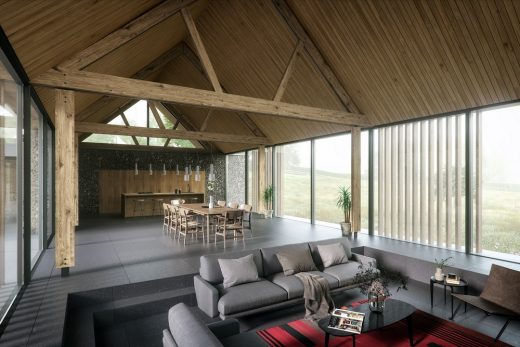Architecture Resources, Architectural Materials, Building Dialogue
Architectural Materials Depletion : Managing Change
Architecture Discussion by Ian K Whittaker
19 Jun 2012
Architecture & Consumer Goods
Article by Ian K Whittaker
2020 and Beyond
World Problem, World Consequences, United Kingdom Issues and Solutions
World Problem
Architectural Materials Depletion: there is one problem that will affect everyone in the World. The age of cheap energy will decline after the year 2020. From 2020 the world wide oil supply will reduce.
Parallel to this reduction in oil supply will be a reduction, year by year, in our societies ability to extract, manufacture, transport, communicate, sell and purchase resources at previous economic levels.
Consumer goods based on petroleum bi-products will become scarce and then unavailable.
Construction is dependent on oil-based products.
How will the Architecture profession adapt to this change?
World Consequences
Here is a list of consumer items. These are dated to a year when they will become a critical resource based on there replacement rate and frequency of their current use.
2020
Oil, industrial lubricant change, fuels, tyres for vehicles. Gas. Note: without oil to lubricate machinery all other manufacturing will become critical
2021
Material extraction from resources, transport, cleaning materials, synthetic glues, transparent non-glass materials, bricks, blocks, slates, roof tiles, timber cutting and transportation, fixings, metals, glass production and transportation, water purification, sewage treatment, detergents, pesticides, animal feeds, medicines, industrial chemicals
2022
Anaesthetics, film tri-acetate, dyes and Inks
2023
Money in metal, paper, plastic and electronic form, computer hard drives
2025
Computers see electrical components, batteries, cars
2030
Building Insulation
2033
Communications Equipment
2035
DVD’s, Paints, train track supports, supervisory control and data acquisition systems
2040
Asphalt, aircraft, plastics, household wiring
2045
Electrical household panels
2050
Ships, credit cards, electrical control & protection schemes
2056
Capacitors
2065
Wood Pole, transmission cables, current transformers, voltage transformers, circuit breakers
2070
Substation switch bays, power transformers, power generation
2075
Distribution system concrete pole, steel pole
2080
Substation Establishment, Steel Towers
2086
Transistors
2200
Film polyester-based
2230
Silicon Controlled Rectifiers. Varistors and Resistors
Here are the issues and solutions related to the United Kingdom:
United Kingdom Problems
The UK has four problem areas.
UK Issue 1 Energy
The United Kingdom reached Peak Oil in 1999.
After 2020 the UK existing National Grid distribution systems for energy extraction, manufacture, transport, communication, and retail will gradually become less efficient.
Solutions.
Energy extraction, manufacture, transport, communication, and retail after 2020 will have to be localized.
Wave energy could be localized to coastal areas but coast to inland extraction, manufacture, transport, distribution will become gradually unsustainable after 2020.
Wind energy could be localized to coast and higher land areas but higher land area and coast to inland extraction, manufacture, transport, and distribution will become gradually unsustainable after 2020.
Bio-energy has very poor energy output to crop extraction, manufacture, transport and distribution ratios and it will become gradually unsustainable after 2020.
Gas energy is running out at the same rate as oil and will become gradually unsustainable after 2020.
Oil energy is running out and will become gradually unsustainable after 2020.
Solar energy has very high initial extraction, manufacture, transport and distribution cost but it is totally sustainable after 2020 if it is integrated into all required appliances by direct connection and minimal distribution systems.
UK Issue 2 Population
The United Kingdom Population is currently 63,047,162 people.
(July 2012 est C.I.A. World fact book.)
It is projected to reach 77,000,000 by 2050.
(US Population Reference Bureau)
There were 26.3 million households in the UK in 2011.
(Source UK Office of National Statistics. Families and households, 2001 to 2011)
This allows currently for 2 people per dwelling type. Detached, Semi-detached, bungalow, terraced, apartment.
Each home will have to adapt for a minimum of 3 people by 2050 and so density will need to increase.
Land is not available to develop new homes over the whole of the United Kingdom.
New housing policies will be needed after 2020.
Solutions.
Existing homes will need to be adapted to new energy sources and converted to multiple occupancy to allow for future increases in population.
Single dwellings will need to be adapted into multiple self contained apartments.
New homes will only need to be built where no existing ones can be adapted. All new homes will need to be a maximum of one third the size of the current house form to save land area and achieve required density whilst allowing for the reducing availability of manufactured products.
By reducing house plan area and compacting its volume, land, extraction, material, manufacture, transport, communicate, energy, running cost resources are all reduced and extended.
Passive natural systems can be used to heat, and cool buildings to remove the density of services within each building envelope.
The actual time use for each house is also acknowledged through its form.
The majority of homes in the UK are empty for between 10 – 14 hours each day.
People are living outside and using homes as storage areas for themselves, family and possessions.
By reducing plan area and compacting volume, plan forms can become more open and less cellular allowing better space utilization, unnecessary construction, and unnecessary services.
Moving from cellular to open plan will also reinforce individual, family and cultural values.
Planning and Building approval should be amended to allow sleeping accommodation and sanitary facilities in permitted development.
UK Issue 3. Land
Land availability in the United Kingdom
Total land area 243,610 km2, 94,060 sqm (Wikipedia)
Arable land: 23.23%, Permanent Crops: 0.2%, Other: 75.23%, water 1.34% (Source. C.I.A. World Fact book)
Available urban land is 183268 km2, 70761 sqm (Total less Arable, less Permanent Crops, less water)
Density of population 255.6/km2, 661.9/sqm (Wikipedia)
Population increase will be paralleled by greater food, water, shelter, health, hygiene, energy requirements.
Solutions.
Land in green belt areas will need to be converted into manual food, energy and resource production over the whole of the UK.
Farms will need to be converted into energy production, water treatment, sewage treatment, arboriculture, aquaculture, air treatment, bio-fuel production, communication production, horse and pony production, cattle and sheep stations, chicken and aviary stations.
Land boundaries will need to be mapped locally over the whole country. Local civil works obligations will need to be introduced to integrate the public into the new post-oil energy economy.
Work will need to be reconnected to the needs of water, food, shelter, health, hygiene and energy.
UK Issue 4. Administration
Each area in the United Kingdom has a different climate, land use, population density, water, food, shelter, health, hygiene and energy requirement.
After 2020 the energy, communication and transport systems will gradually become less efficient. The administration system for the United Kingdom will have to be localized to cope with these changes.
Solutions.
Administration will need to be localised at a local authority council level.
Taxation control will need to be completely localised at a local authority council level.
Regulations will need to be reduced.
Summary.
The waste economics of Consumerism are over.
Needs must replace wants and desires again.
Article by Ian K Whittaker
Architectural Energy Depletion
Architectural Articles – Selection
Placebo Architecture : article by Karolina Szynalska – 27 Sep 2011
Architecture Narrative : article by Trevor Tucker. 24 Aug 2010
Nature Architecture : article by Trevor Tucker. 15 Sep 2009
Sustainable Buildings – Building Issues : article by Adrian Welch
Design: AR Design Studio Architects

render : The Faction
The Barns Family Home
Comments / photos for the Architecture Materials – Architectural Resources Article page welcome






